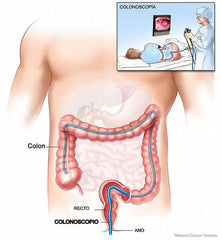Hemorrhoids Colonoscopy Guide - Can a Doctor Fix Your Hemorrhoids During a Colonoscopy
Posted on 15 July 2018 by Maryanne Johnson
Share this post
Do you want the doctor to find and fix your hemorrhoid during a colonoscopy? Colonoscopies allow for doctors to detect for cancer and evaluate for gastrointestinal disorders like colon polyps, diverticulitis, abdominal pain, and inflammatory bowel disease.
A colonoscopy is a routine procedure, aimed at examining adults who are 50 years old or older.
A doctor can check for hemorrhoids when you get a colonoscopy.
A colonoscopy is extremely useful in detecting and preventing colorectal cancers. During a colonoscopy, your doctor will search for colon polyps by employing the use of a colonoscope, a flexible instrument inserted through the anus that can be manually maneuvered.
There are natural methods you can use for your hemorrhoids. HemRid Max is an herbal hemorrhoid supplement that attacks hemorrhoids from the inside-out. If you are having pain, it could be a great option for you.
The colonoscope traverses through the rectum, using a fiber optic camera to detect polyps.
A colonoscopy is telling procedure and doctors can get a firsthand visual of the status of the colon and intestine. During a colonoscopy, your doctor will remove polyps found in the colon.
It is essential to identify polyps in the colon because some have the potential to become cancerous, while others can remain benign.
If rectal bleeding is an issue for the patient, doctors can locate the source and extract a tissue sample for biopsy.
Usually, a case of hemorrhoids does not prompt your doctor to perform a colonoscopy unless there is a substantial or reoccurring symptom of anal bleeding or complications with your hemorrhoids.
Rectal bleeding is a shared symptom of hemorrhoids, colon polyps, and colon cancer, and depending on other circumstances and factors, your doctor may opt to perform a colonoscopy.
What if Hemorrhoids are Found During a Colonoscopy?
Many different aspects of a patient's medical history are considered during diagnosis. For a relatively healthy and normal individual complaining of minor rectal bleeding, bumps on the anus or nearby, and general anal-rectal discomfort, doctors will almost always initially suspect hemorrhoids.
Hemorrhoids become increasingly more of an issue for older adults, men and women alike. Hemorrhoids also pop up during pregnancy, especially the third trimester and following delivery. These variables are weighed if a patient reports itching, burning, and feeling uncomfortable in certain positions.
To ensure that the patient is experiencing hemorrhoids, doctors can perform a digital or visual examination. A digital exam is when the doctor inserts his or her lubricated and gloved finger inside the rectum to determine if inflammation or an internal hemorrhoid is present. A visual exam is completed for external hemorrhoids.
In rare instances, a colonoscopy may be ordered if a patient reports recurrent rectal bleeding or hemorrhoids that seem to be frequently occurring. Hemorrhoids also have a tendency to happen at the same age a colonoscopy is required. These two issues may coincide, and your doctor may need one to be completed regardless.
Either way, it is never a bad idea to have a colonoscopy if you are facing colorectal issues, worsening hemorrhoids, or are about 50 years old and have not had one completed. A colonoscopy has proven its effectiveness in preventing and identifying colorectal cancer and gastrointestinal disorders.
Perhaps you have already had a colonoscopy performed, and your doctor has informed you of the results. If hemorrhoids have been found internally during the colonoscopy, your doctor will advise you on different methods of treatment.
Internal hemorrhoids, as stated previously, can also be detected through a digital examination. If this type of hemorrhoid is discovered in either test, your internal hemorrhoid will then be categorized in varying Grades or Degrees.
Grade I hemorrhoids often produce a single symptom of painless hemorrhoid bleeding. This symptom may also be the reason for a prompted colonoscopy. Grade II through Grade IV include a stage of prolapse based on severity.
Can Hemorrhoids Be Removed During a Colonoscopy?
Depending on your doctor, the state of your internal hemorrhoid, and the procedure itself, your internal hemorrhoids can be treated at the time of the colonoscopy. The most common form of internal hemorrhoid treatment for the majority of the Grades of internal hemorrhoids is called Rubber Band Ligation.
A small band is placed around the internal hemorrhoid, cutting off its blood supply. This method of strangulation forces the internal hemorrhoid to fall off in a matter of days.
Rubber Band Ligation, even when performed outside of a colonoscopy, only requires three office visits for full completion. It is a non-operative procedure that does not require a sedative with a low risk of infection or other complications.
In some cases, it can be expensive, especially when you do not have insurance.
In cases of external hemorrhoids, a colonoscopy is not needed because this type of hemorrhoid can be detected outside of the rectum in a visual examination. External hemorrhoids are hard lumps on the outside of the anus.
If your doctor requires further confirmation that the symptoms you are describing are the source of an external hemorrhoid, a visual examination can be performed. This examination is where your doctor inspects the anal-rectal area to detect for a visual indication of external hemorrhoids.
If your colonoscopy coincides with a painful and frustrating external hemorrhoid flare-up, you can proceed with an option of having your hemorrhoids treated during this procedure.
A complication with an external hemorrhoid can consist of a blood clot becoming trapped under the surface of the skin, and this is called a thrombosed hemorrhoid. Thrombosed hemorrhoids are even more painful in comparison to an uncomplicated external hemorrhoid.
Thrombosed hemorrhoids can cause throbbing pain and discomfort in what are ordinarily comfortable positions. These blood clots make movement painful and should be dealt with immediately.
You or your hemorrhoid doctor can visually inspect a thrombosed hemorrhoid, and unlike an external hemorrhoid, a blood clot will give the hemorrhoid a bluish or purple color.
During a colonoscopy, your doctors can lance and drain a thrombosed hemorrhoid if this is needed. Even with an in-office visit, your doctor can do this, but because the preparations have already been done for a colonoscopy, the timing may be ideal to have this taken care of during this procedure.
Talk to your doctor about options for external hemorrhoid removal during your colonoscopy. In this day and age, there are numerous treatment methods available for patients with varying degrees of internal hemorrhoids and those with severe external hemorrhoids.
One great method to use for hemorrhoid relief is an herbal supplement.
Our #1 supplement is called HemRid. It works great to relieve the symptoms of hemorrhoids.
Colonoscopy Prep & Hemorrhoids
The preparations required for a colonoscopy are thorough and can have you in the bathroom for the entire day or evening before your procedure. Although this is tedious and exhausting, the prep for a colonoscopy is necessary. A clean, empty colon will allow your doctors to examine your colon, detect cancerous signs, and treat even the smallest polyps.
Your doctor will provide you with an instruction sheet when your colonoscopy is officially scheduled. It is essential that you examine these instructions and ask your doctor about any questions before your procedure.
You can plan in advance for your colonoscopy by altering your diet days beforehand. Choose low fiber foods, light meals, and foods that are easily digested and leave your system quickly, as you will be taking a laxative prescribed by your doctor to empty your colon before your procedure.
If you have hemorrhoids during the prepping part of your colonoscopy, make sure you pick up the items needed to make yourself more comfortable.
This can include witch hazel wipes, creams, suppositories, supplements, pills, pillows, cushions, and more.
Try HemRid Max (hemorrhoid pills) for quick relief.
These are the foods to avoid in the days leading up to your Colonoscopy include:
- Whole grains
- Nuts
- Peas
- Beans
- Popcorn
- Fatty foods
- Fruits with seeds or skins
- Corn
- Broccoli
- Cabbage
- Raw vegetables
In the case of rectal bleeding from your internal hemorrhoids, continue following your instructions for prep while keeping an eye on your bowel movements. If the bleeding becomes heavy or does not stop, then you should contact your doctor.
Otherwise, bleeding hemorrhoids should be treated with creams. It is recommended that you try to finish your prep.
The day before your procedure is when you must avoid eating any solid foods. Your doctor will want you to stay hydrated, drinking lots of sports drinks and other clear liquids.
Although solid foods are not allowed during this part of the prep, you can still have gelatin and ice pops, but avoid ones that are colored red, purple, or blue, as the dye can disrupt the natural color of the colon.
HemRid Max works for hemorrhoids. Click here to learn more.
Two hours prior to your procedure, make sure you do not eat or drink anything. With your colon empty and cleaned, your doctor can do an accurate colonoscopy.






0 comments